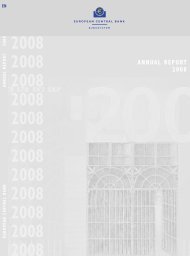Reserve Bank of Australia Annual Report 2011
Reserve Bank of Australia Annual Report 2011
Reserve Bank of Australia Annual Report 2011
Create successful ePaper yourself
Turn your PDF publications into a flip-book with our unique Google optimized e-Paper software.
Foreign currency swaps<br />
The RBA uses foreign currency swaps with market counterparties to assist daily domestic liquidity management<br />
and to manage balance sheet holdings. A foreign currency swap is the simultaneous purchase and sale <strong>of</strong> one<br />
currency against another currency for specified maturities. The cash flows are the same as borrowing one<br />
currency for a certain period, and lending another currency for the same period. The pricing <strong>of</strong> the swap must<br />
therefore reflect the interest rates applicable to these money market transactions. Interest rates are implicit in<br />
the swap contract but interest itself is not paid or received.<br />
Foreign exchange holdings contracted for sale beyond 30 June <strong>2011</strong> (including those under swap contracts)<br />
have been valued at market exchange rates (Note 15).<br />
Interest rate futures<br />
The RBA uses interest rate futures contracts on overseas exchanges to manage interest rate risk on its portfolio<br />
<strong>of</strong> foreign securities. An interest rate futures contract is a contract to buy or sell a specific amount <strong>of</strong> securities<br />
for a specific price on a specific future date.<br />
Interest rate futures positions are classified under AASB 139 as ‘at fair value through pr<strong>of</strong>it or loss’. In accordance<br />
with this standard, futures positions are marked to market on balance date at the relevant bid or <strong>of</strong>fer price<br />
and valuation gains and losses taken to pr<strong>of</strong>it. Only realised gains and losses are available for distribution in<br />
accordance with the <strong>Reserve</strong> <strong>Bank</strong> Act 1959 (Note 1(f)).<br />
<strong>Bank</strong> for International Settlements<br />
Under AASB 139 the RBA’s shareholding in the <strong>Bank</strong> for International Settlements (BIS) is classified as ‘available<br />
for sale’ for accounting purposes. The shareholding is valued at fair value and revaluation gains and losses are<br />
transferred directly to the revaluation reserve for shares in international and other institutions (Note 5). The fair<br />
value is estimated on the basis <strong>of</strong> BIS’ net asset value, less a discount <strong>of</strong> 30 per cent. When declared, dividends<br />
are recognised as revenue in the Statement <strong>of</strong> Comprehensive Income.<br />
Financial Liabilities<br />
Deposit liabilities<br />
Deposits include deposits at call and term deposits. Deposits are classified as financial liabilities under<br />
AASB 139. Deposit balances are shown at their amortised cost, which is equivalent to their face value. Interest<br />
is accrued over the term <strong>of</strong> deposits and is paid periodically or at maturity. Interest accrued but not paid is<br />
included in Other Liabilities (Note 10). Details <strong>of</strong> Deposits are included in Note 9.<br />
<strong>Australia</strong>n notes on issue<br />
Notes on issue are recorded at face value. Prior to 2005/06, the RBA periodically adjusted its liability for note<br />
series that had ceased to be issued – to reflect the likelihood that the remaining notes on issue from these<br />
series would not be presented for redemption – and the gains were included in accounting pr<strong>of</strong>its. If the<br />
written down notes are subsequently presented, the RBA charges an expense against pr<strong>of</strong>its. In 2010/11,<br />
notes with a face value <strong>of</strong> $227 643 which had previously been written down were presented to the RBA and<br />
expensed ($234 211 in 2009/10).<br />
The RBA pays interest on working balances <strong>of</strong> currency notes held by banks under cash distribution<br />
arrangements. Interest is paid on balances up to certain limits.<br />
<strong>Annual</strong> report <strong>2011</strong> | notes to the financial statements<br />
79





![KNOW YOUR NEW GIBRALTAR BANKNOTES - [Home] bThe/b](https://img.yumpu.com/50890985/1/184x260/know-your-new-gibraltar-banknotes-home-bthe-b.jpg?quality=85)
![PAPUA NEW GUINEA - [Home] - Polymer Bank Notes of the World](https://img.yumpu.com/49758743/1/190x143/papua-new-guinea-home-polymer-bank-notes-of-the-world.jpg?quality=85)










